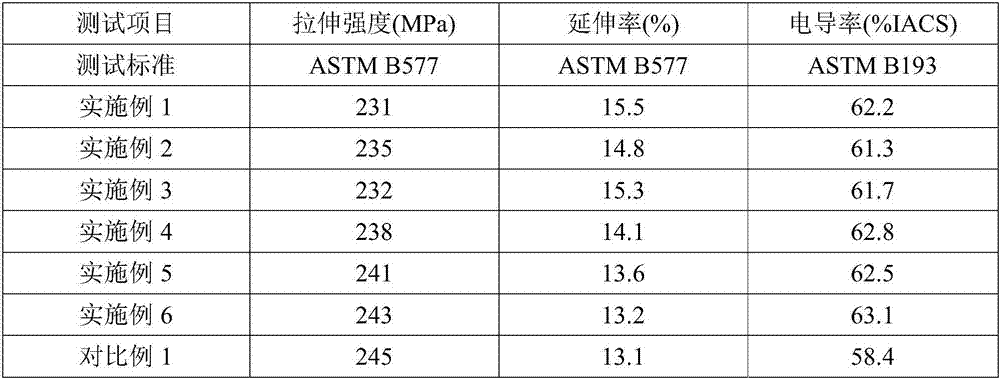Aluminum alloy material, preparation method of aluminum alloy material and application
A technology for aluminum alloy materials and aluminum alloy ingots, applied in the field of alloy materials, can solve the problems of inability to meet medium-strength aluminum alloy wires and low tensile strength, and achieve high tensile strength, tensile strength and improved electrical conductivity. Effect
- Summary
- Abstract
- Description
- Claims
- Application Information
AI Technical Summary
Problems solved by technology
Method used
Image
Examples
Embodiment 1
[0048] An aluminum alloy material, comprising the following components in mass percentage:
[0049] 0.25% of iron, 0.25% of copper, 0.2% of magnesium, 0.15% of zinc, 0.1% of silicon, 0.05% of boron, 0.2% of scandium and 0.15% of ruthenium, and the balance is aluminum.
[0050] The preparation method of above-mentioned aluminum alloy material is as follows:
[0051] (1) After melting the aluminum ingot in a vacuum melting furnace, add iron, copper, magnesium, zinc, silicon, boron, scandium and ruthenium according to the formula, melt it at 1200°C for 6 hours, and then cast it into an aluminum alloy ingot;
[0052] (2) Homogenize the aluminum alloy ingot at 500° C. for 28 hours, then water quench to obtain a homogenized aluminum alloy ingot;
[0053] (3) The above-mentioned homogenized aluminum alloy ingot was subjected to aging treatment at 130° C. for 12 hours to obtain the above-mentioned aluminum alloy material.
Embodiment 2
[0055] An aluminum alloy material, comprising the following components in mass percentage:
[0056] 0.35% iron, 0.1% copper, 0.4% magnesium, 0.05% zinc, 0.3% silicon, 0.01% boron, 0.35% scandium and 0.05% ruthenium, and the balance is aluminum.
[0057] The preparation method of above-mentioned aluminum alloy material is as follows:
[0058] (1) After melting the aluminum ingot in a vacuum melting furnace, add iron, copper, magnesium, zinc, silicon, boron, scandium and ruthenium according to the formula, melt it at 1500°C for 2 hours, and then cast it into an aluminum alloy ingot;
[0059] (2) Homogenize the above-mentioned aluminum alloy ingot at 550°C for 16 hours, and then water quench to obtain a homogenized aluminum alloy ingot;
[0060] (3) The above-mentioned homogenized aluminum alloy ingot was subjected to aging treatment at 180° C. for 6 hours to obtain the above-mentioned aluminum alloy material.
Embodiment 3
[0062] An aluminum alloy material, comprising the following components in mass percentage:
[0063] 0.26% of iron, 0.23% of copper, 0.22% of magnesium, 0.14% of zinc, 0.13% of silicon, 0.04% of boron, 0.23% of scandium and 0.135% of ruthenium, and the balance is aluminum.
[0064] The preparation method of above-mentioned aluminum alloy material is as follows:
[0065] (1) After melting the aluminum ingot in a vacuum melting furnace, add iron, copper, magnesium, zinc, silicon, boron, scandium and ruthenium according to the formula, melt it at 1300°C for 4 hours, and then cast it into an aluminum alloy ingot;
[0066] (2) Homogenize the above-mentioned aluminum alloy ingot at 520°C for 24 hours, and then water quench to obtain a homogenized aluminum alloy ingot;
[0067] (3) The above-mentioned homogenized aluminum alloy ingot was subjected to aging treatment at 150° C. for 8 hours to obtain the above-mentioned aluminum alloy material.
PUM
| Property | Measurement | Unit |
|---|---|---|
| tensile strength | aaaaa | aaaaa |
| tensile strength | aaaaa | aaaaa |
| tensile strength | aaaaa | aaaaa |
Abstract
Description
Claims
Application Information
 Login to View More
Login to View More - R&D
- Intellectual Property
- Life Sciences
- Materials
- Tech Scout
- Unparalleled Data Quality
- Higher Quality Content
- 60% Fewer Hallucinations
Browse by: Latest US Patents, China's latest patents, Technical Efficacy Thesaurus, Application Domain, Technology Topic, Popular Technical Reports.
© 2025 PatSnap. All rights reserved.Legal|Privacy policy|Modern Slavery Act Transparency Statement|Sitemap|About US| Contact US: help@patsnap.com


